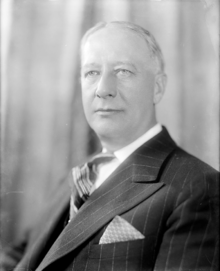Governor Al Smith
| Alfred E. Smith | |
|---|---|

Photo of Smith by Harris & Ewing
|
|
| 42nd Governor of New York | |
|
In office January 1, 1923 – December 31, 1928 |
|
| Lieutenant |
George R. Lunn (1923–1924) Seymour Lowman (1925–1926) Edwin Corning (1927–1928) |
| Preceded by | Nathan L. Miller |
| Succeeded by | Franklin D. Roosevelt |
|
In office January 1, 1919 – December 31, 1920 |
|
| Lieutenant | Harry C. Walker |
| Preceded by | Charles S. Whitman |
| Succeeded by | Nathan L. Miller |
| 8th President of the New York City Board of Aldermen | |
|
In office January 1, 1917 – December 31, 1918 |
|
| Preceded by | Frank L. Dowling |
| Succeeded by | Robert L. Moran |
| Member of the New York State Assembly from the New York County, 2nd district |
|
|
In office January 1, 1904 – December 31, 1915 |
|
| Preceded by | Joseph P. Bourke |
| Succeeded by | Peter J. Hamill |
| Personal details | |
| Born |
Alfred Emanuel Smith December 30, 1873 Manhattan, New York, U.S. |
| Died | October 4, 1944 (aged 70) Manhattan, New York City |
| Political party | Democratic |
| Spouse(s) | Catherine Ann Dunn |
| Children | 5 |
| Religion | Roman Catholic |
Alfred Emanuel "Al" Smith (December 30, 1873 – October 4, 1944) was an American statesman who was elected Governor of New York four times and was the Democratic U.S. presidential candidate in 1928.
Smith was the foremost urban leader of the Efficiency Movement in the United States and was noted for achieving a wide range of reforms as governor in the 1920s. The son of an Irish-American mother and a Civil War veteran father, he was raised in the Lower East Side of Manhattan near the Brooklyn Bridge, where resided for his entire life. Like many other New York politicians of his era, he was also linked to the notorious Tammany Hall political machine that controlled New York City's politics, although he remained personally untarnished by corruption. Smith was a strong opponent of Prohibition, which he did not think could be enforced, and viewed it as an over-extension of the government's constitutional power. He was also the first Catholic nominee for President. His candidacy mobilized Catholic votes, especially from women, who had only recently received federal suffrage. It also brought out the anti-Catholic vote, which was especially strong among white conservative Democrats in the South, although Smith was still successful within the states of the traditional Deep South.
As a committed "wet," or anti-Prohibition, candidate, Smith attracted not only drinkers but also voters angered by the corruption and lawlessness that developed alongside prohibition. Many Protestants feared his candidacy, including German Lutherans and Southern Baptists, believing that the Catholic Church and the Pope would dictate his policies. Most importantly, this was a time of national prosperity under a Republican White House. Smith lost in a landslide to Republican Herbert Hoover, who gained electoral support from six southern states. Four years later Smith sought the 1932 nomination but was defeated by Franklin D. Roosevelt, his former ally and successor as Governor of New York. Smith entered business in New York City and became an increasingly vocal opponent of Roosevelt's New Deal, believing that its true agenda was to make the American people less "self-reliant and independent.” He ultimately went on to support Republican nominees Alf Landon in the 1936 presidential election and Wendell Willkie in the 1940 presidential election.
...
Wikipedia
